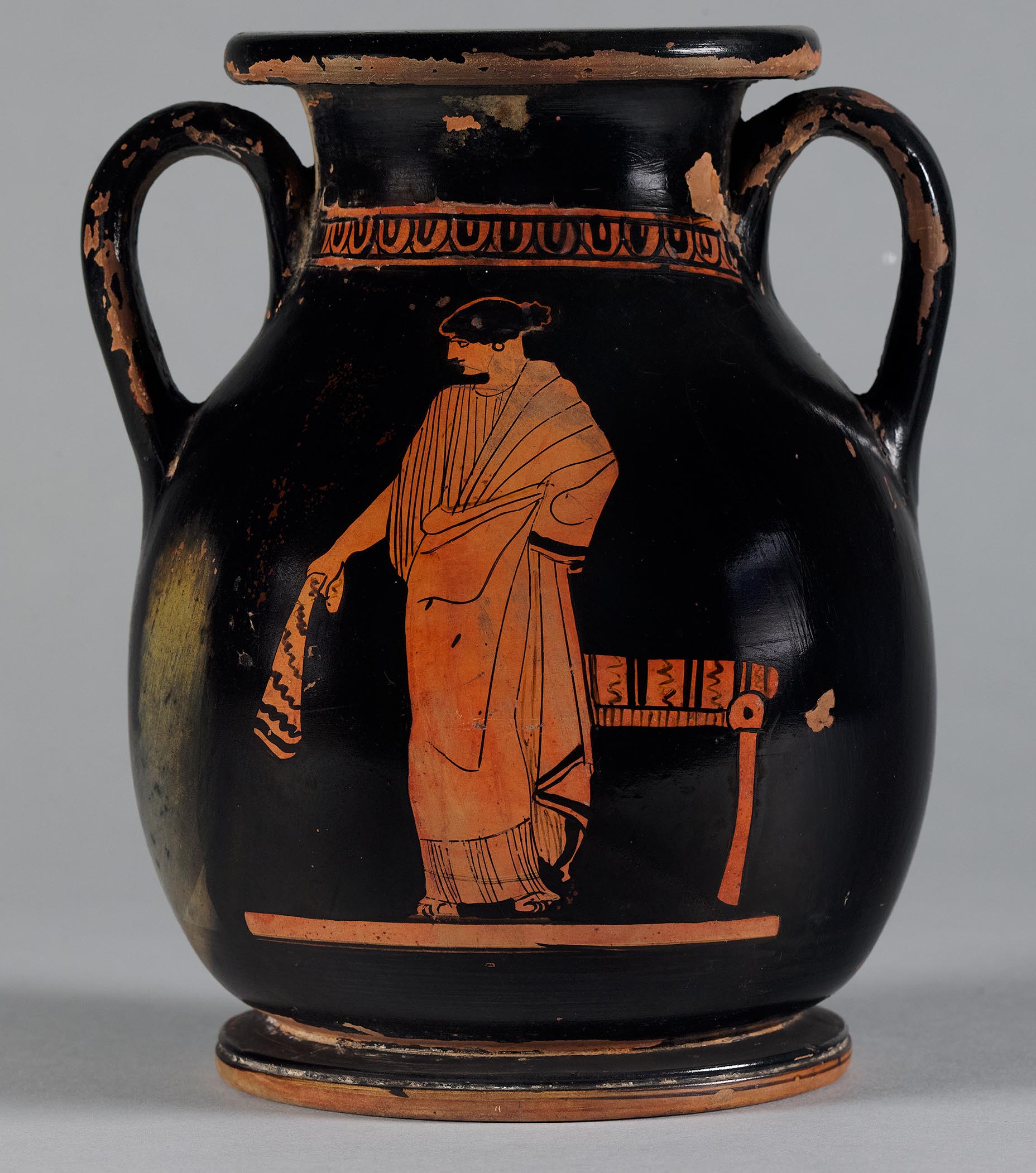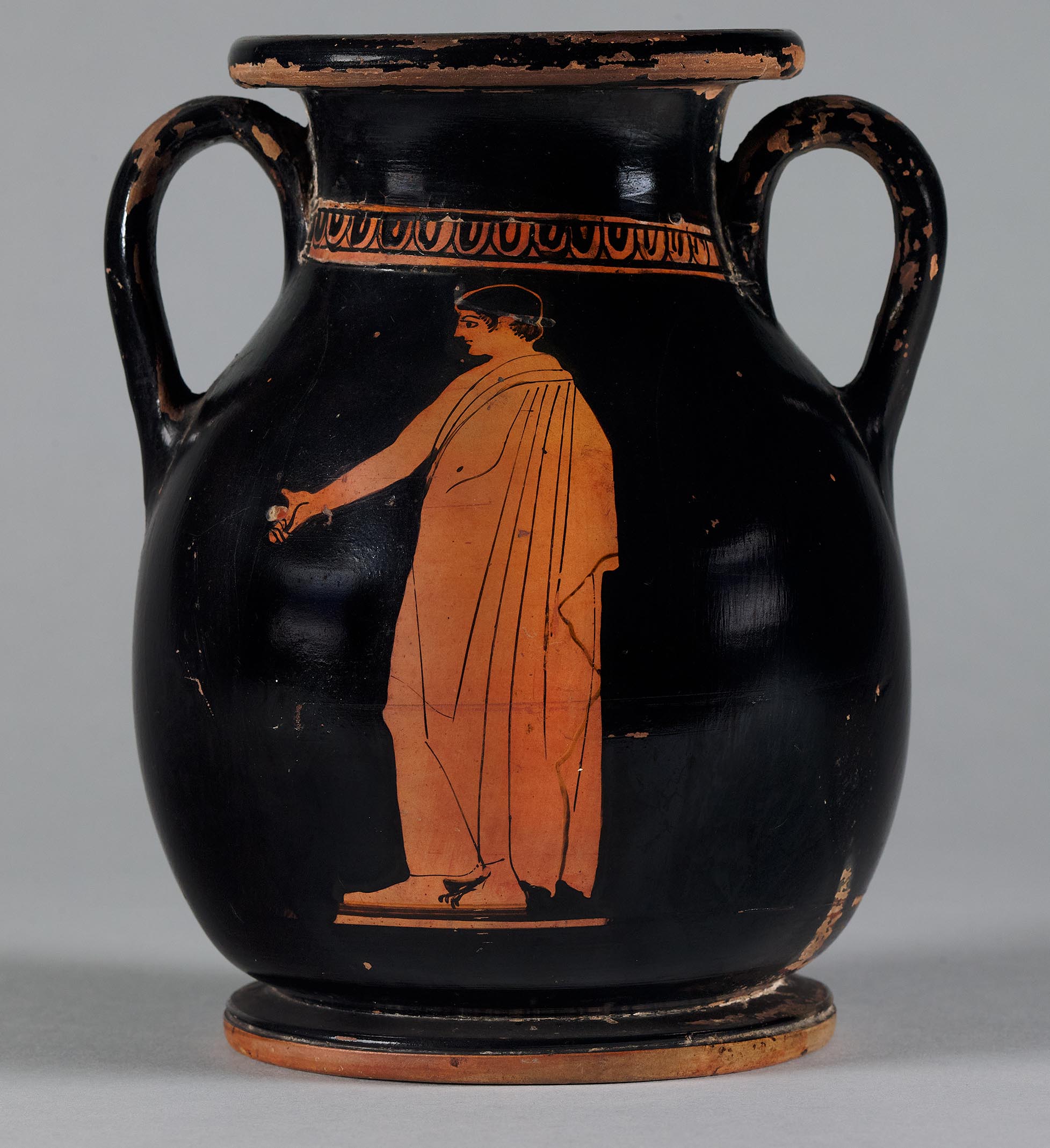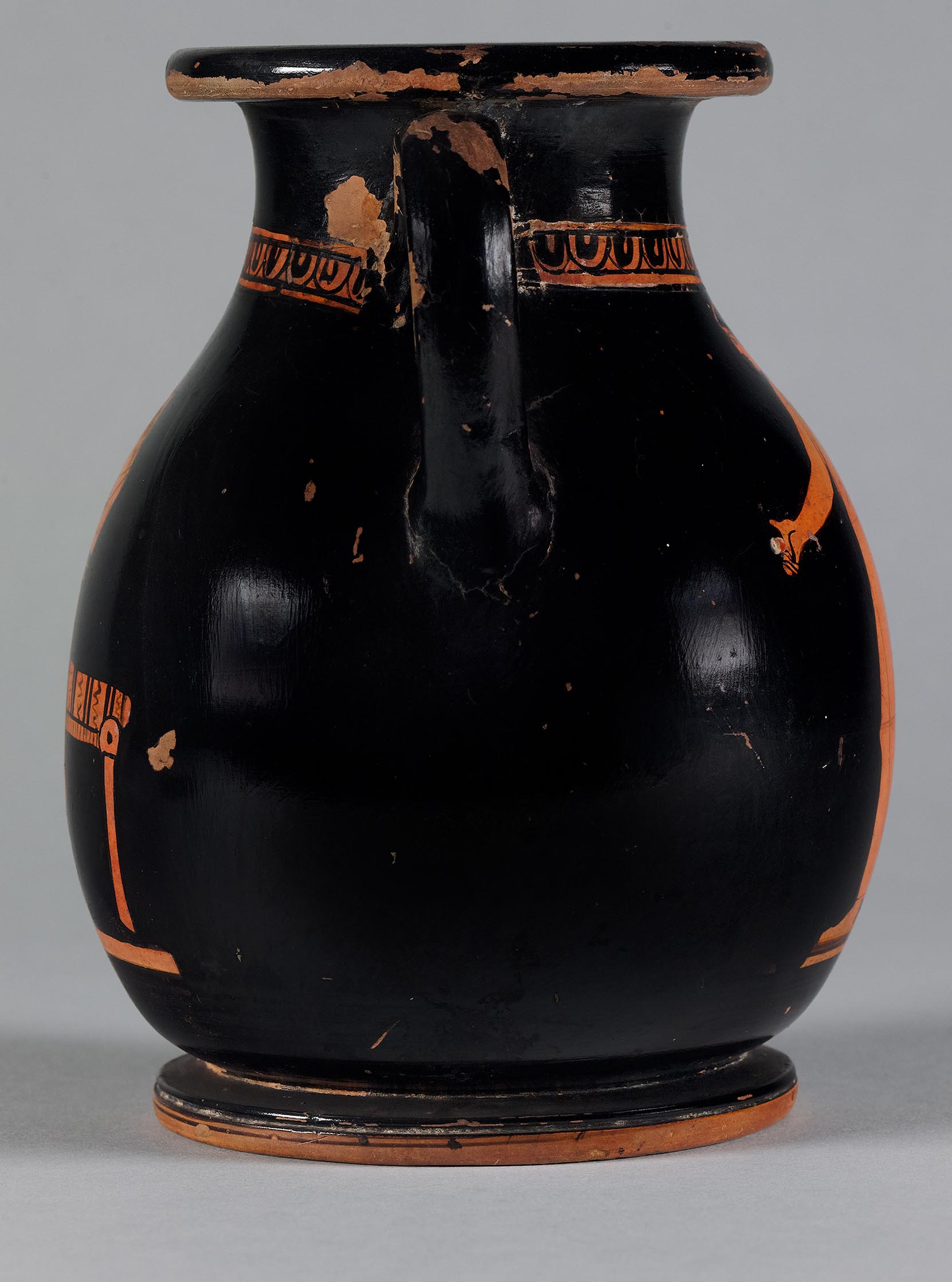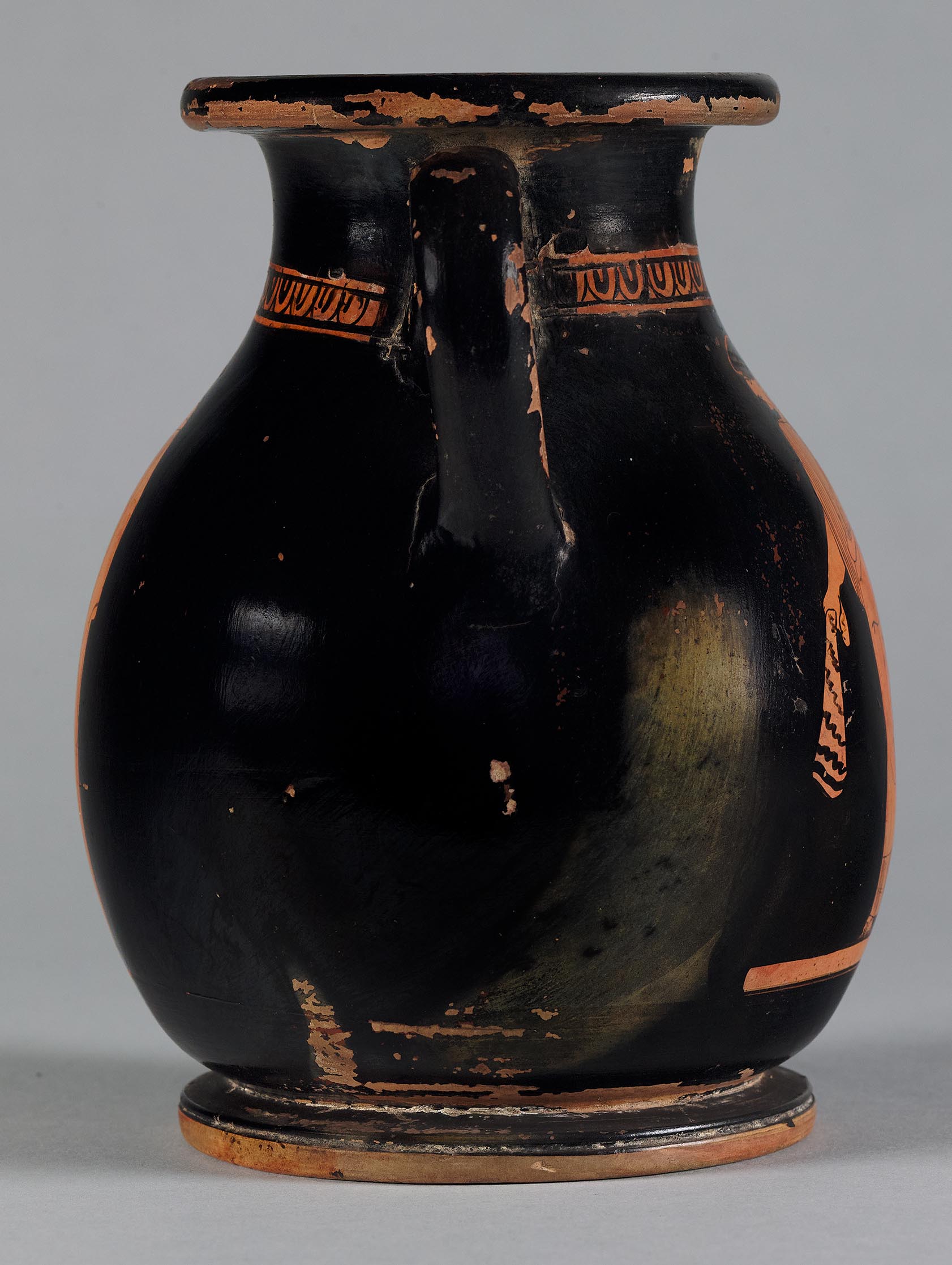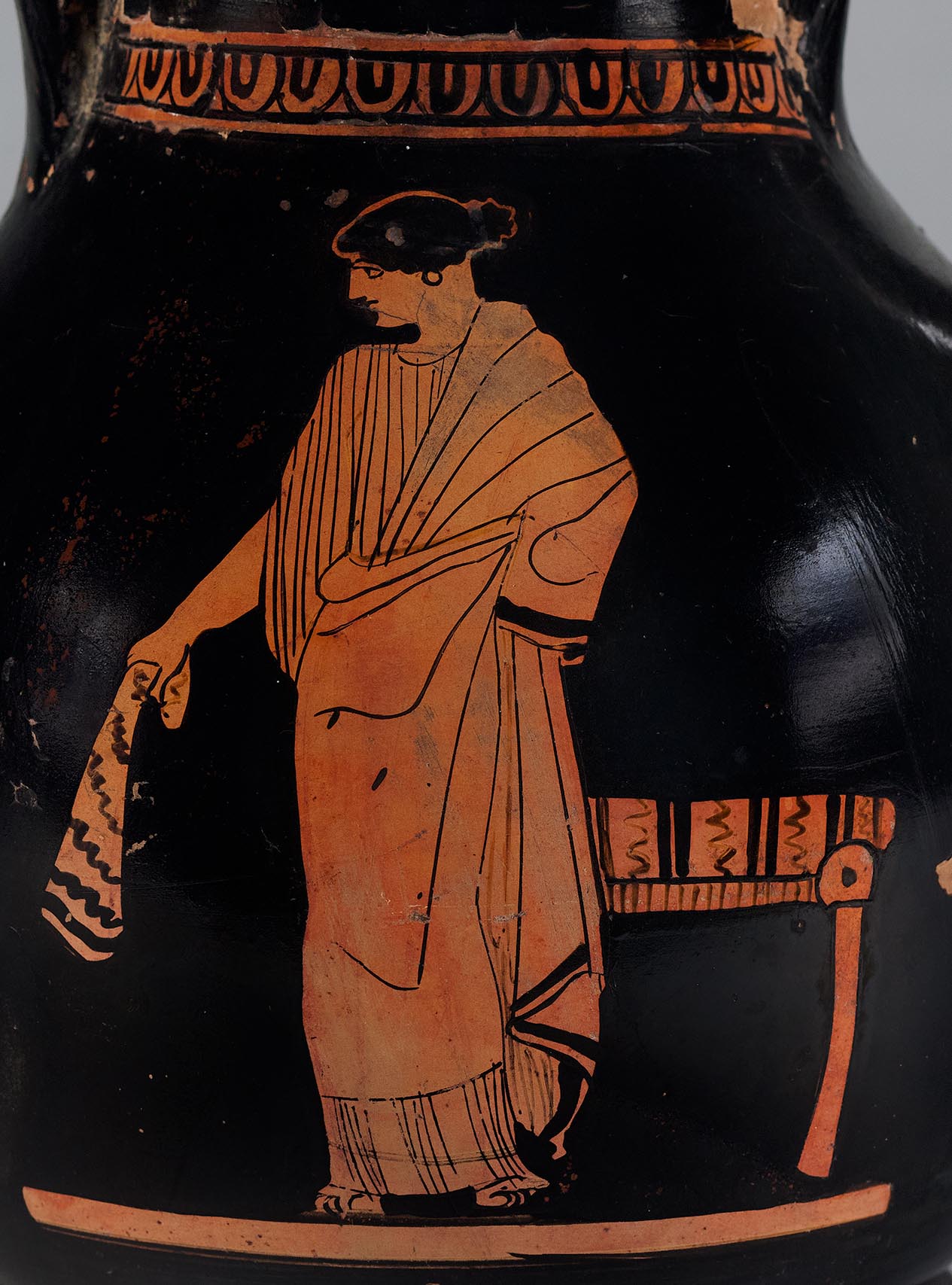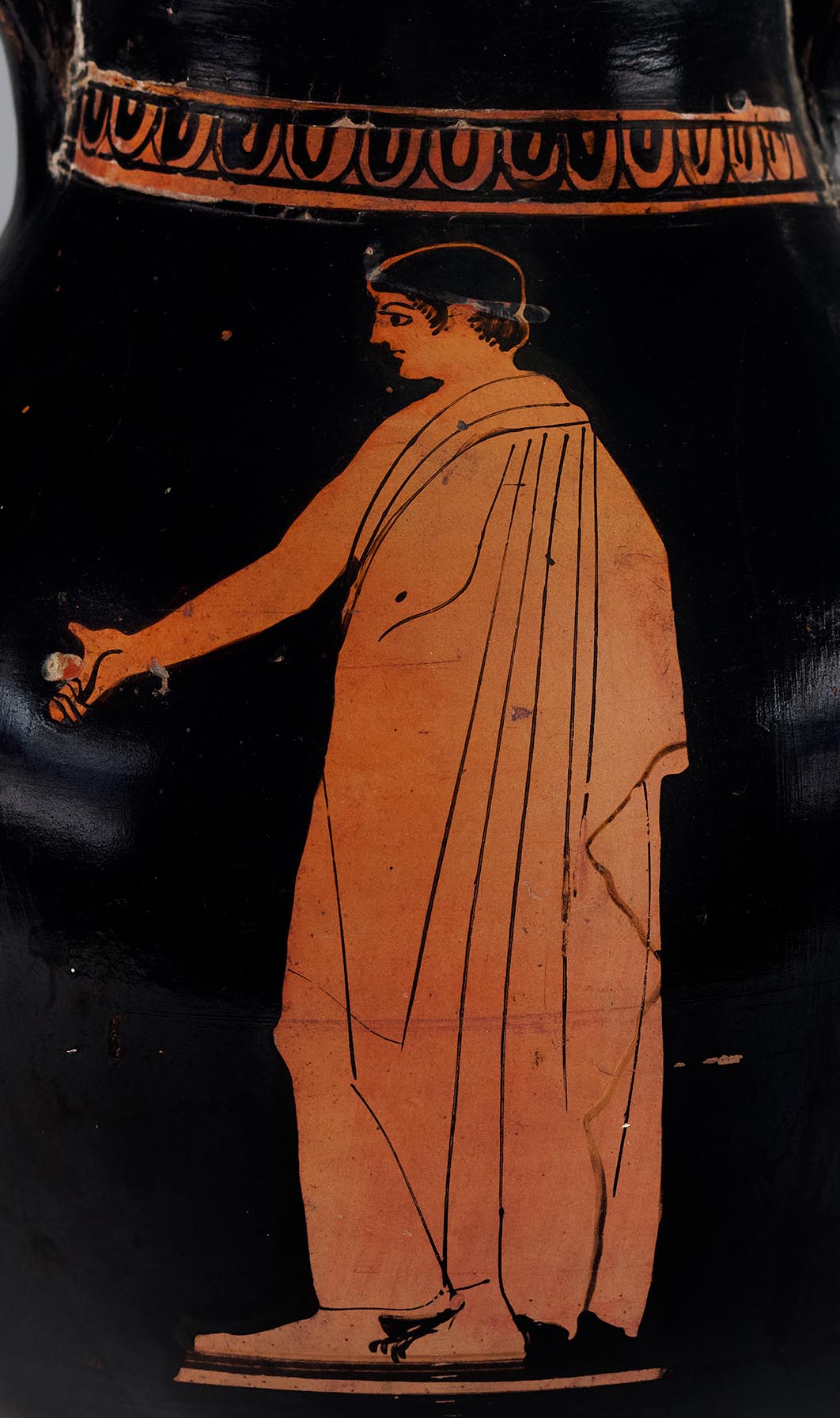Provenance
Between 1890 and 1927, sale, source unknown to Princeton University. The ascription to “Paris, market, Feuardent” in Abbreviation: BAPDBeazley Archive Pottery Database. http://www.beazley.ox.ac.uk 216125 is erroneous (access date 11/15/2022).
Shape and Ornament
Torus rim, black. Short wide neck. Interior of mouth and neck black. Strap handles, black, thicker in middle. Ovoid body, separated from foot by reserved fillet; interior of body streaky, matte black. Disk foot with groove near upper edge. Shallow, concave molding underneath; wide resting surface (w. 1.8 cm). Top of foot and side above groove black (reserved below groove); wash of pink miltos (ocher) on the reserved underside. A band of ovolo, framed by paired horizontal lines, extends between the upper handle roots on either side. Figure panels are unframed. Thick reserved groundlines.
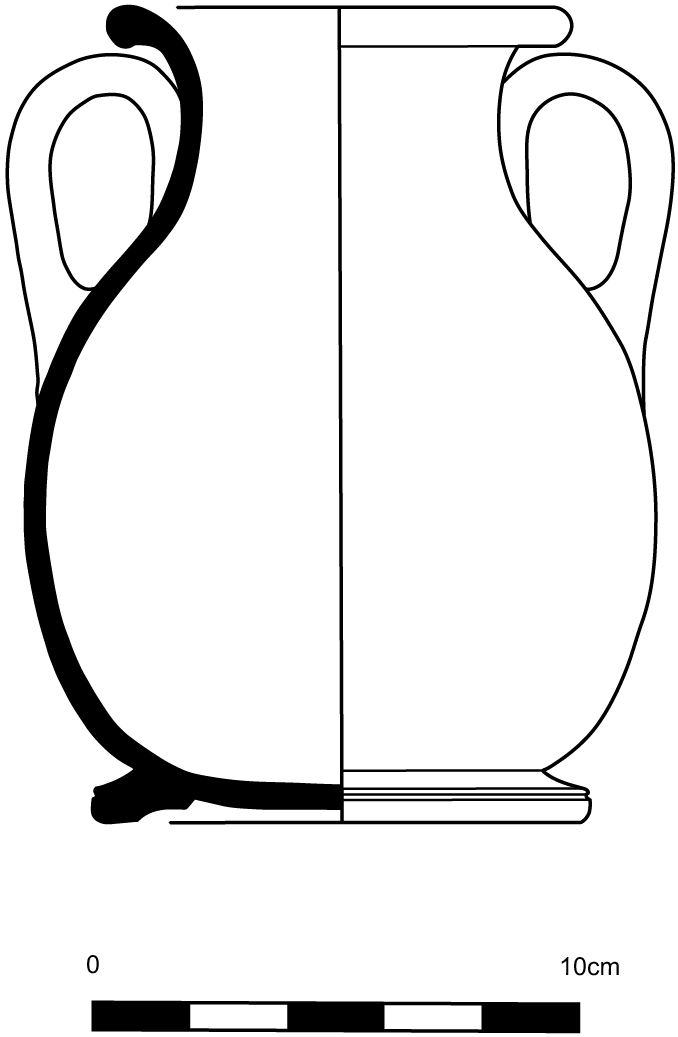
Subject
A. Standing woman with diphros (stool). A woman, barefoot and wearing a long chiton and himation, stands with her body facing forward and her head turned to the left; her left hand rests on her hip, beneath her cloak, and she holds a sakkos with wavy lines in her right hand. Her hair is gathered in a chignon and bound with a pair of white fillets. For jewelry, she wears a hoop earring. Behind her stands a diphros, with a cushion decorated with paired straight lines alternating with a single wavy line.
B. Male youth. A young male stands in profile to the left, his right leg advanced, with knee bent. In his extended right hand he holds a white, round object, perhaps a ball, fruit, or egg. He is barefoot and wears a white apicate fillet in his short black hair.
Attribution and Date
Attributed to the Naples Painter [J. D. Beazley]. Circa 450–430 BCE.
Dimensions and Condition
h. 17.0 cm; w. 12.9 cm; diam. of mouth 9.5 cm; diam. of foot 10.2 cm. The black gloss is flaked off in patches on the rim, handles, and lower body. In front of the woman is an area of whitish misfiring. Areas of discoloration on the woman, concentrated on her neck and the right side of her torso. The handles are slightly lopsided. The underside is speckled with black incrustation.
Technical Features
Few relief contours: stool leg; lower right himation on side A. Shiny black gloss, with noticeable brushstrokes. Accessory color. White: both figures’ fillets; the object held by the man.
Inscriptions
Incised graffito under foot:
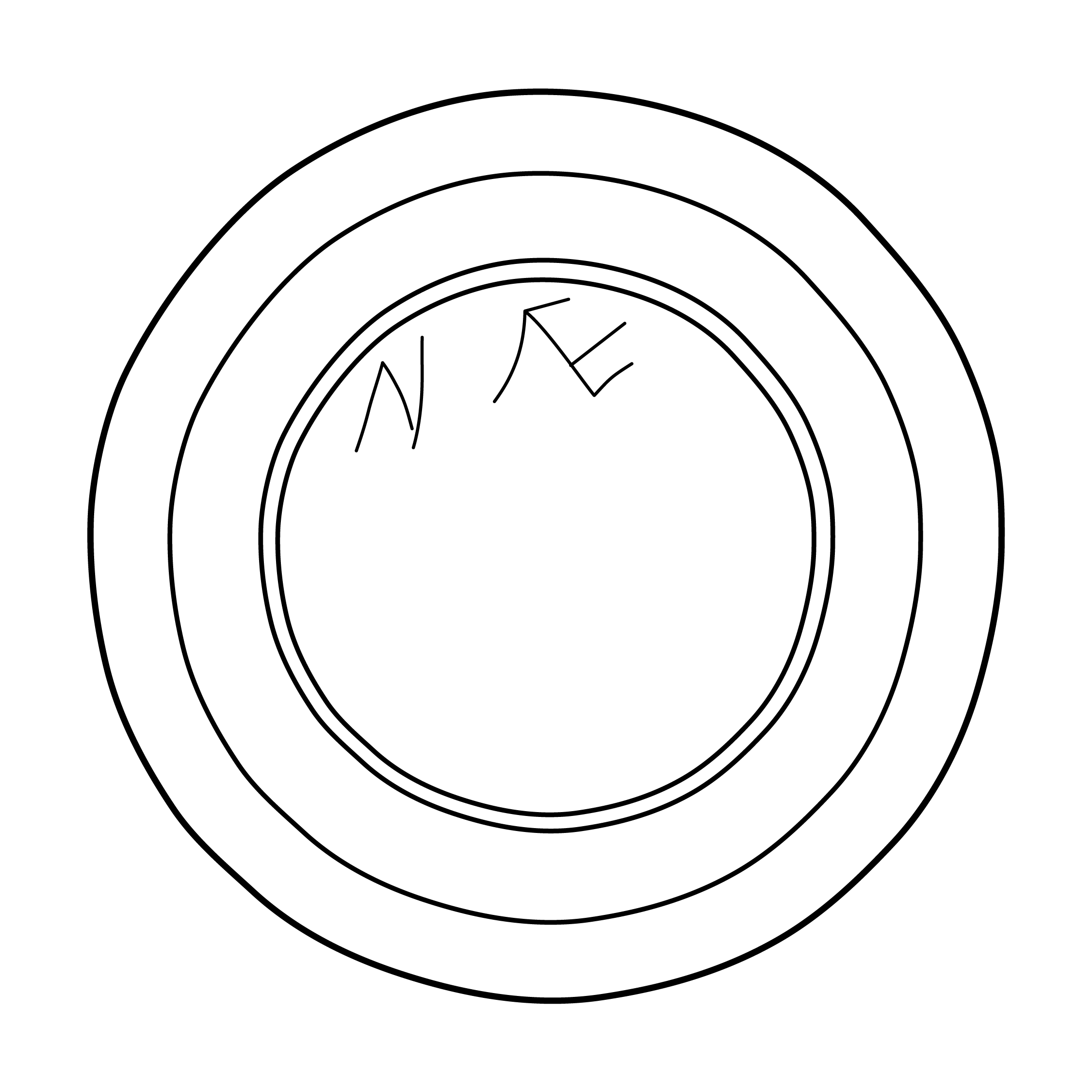
Bibliography
Abbreviation: ARV2J. D. Beazley. Attic Red-Figure Vase-Painters. 2nd ed. Oxford, 1963 1100.57; Abbreviation: BAPDBeazley Archive Pottery Database. http://www.beazley.ox.ac.uk 216125 (where the citations Abbreviation: Att. V.Beazley, J. D. 1925. Attische Vasenmaler des rotfigurigen Stils. Tübingen: Mohr. 263.20 and Abbreviation: ARV1Beazley, J. D. 1942. Attic Red-Figure Vase-Painters. Oxford: Clarendon Press. 564.9 refer to a different vase).
Comparanda
For the Naples Painter, see Princeton 2002-40 (Entry 8). Most of his pelikai are of this type, relatively small and with unframed pictures.
On small red-figure vases, women are frequently represented standing next to a chair or stool, often holding another object or engaged in some kind of domestic activity, such as spinning: e.g., Paris, Cab. Méd. unnumbered (Abbreviation: ARV2J. D. Beazley. Attic Red-Figure Vase-Painters. 2nd ed. Oxford, 1963 624.81; Abbreviation: BAPDBeazley Archive Pottery Database. http://www.beazley.ox.ac.uk 207236). No comparable scene is known by the Naples Painter, but a woman carries a sakkos on one of his lebetes, Karlsruhe B 3078, ii (Abbreviation: ARV2J. D. Beazley. Attic Red-Figure Vase-Painters. 2nd ed. Oxford, 1963 1098.36; Abbreviation: BAPDBeazley Archive Pottery Database. http://www.beazley.ox.ac.uk 216103), and a similar snood hangs on the wall among the women on an unnumbered hydria fragment in Copenhagen (Abbreviation: ARV2J. D. Beazley. Attic Red-Figure Vase-Painters. 2nd ed. Oxford, 1963 1100.59; Abbreviation: BAPDBeazley Archive Pottery Database. http://www.beazley.ox.ac.uk 216127). The inclusion of a stool could indicate that the scene takes place indoors, in the gynaikonitis or gynaeceum. For the shifting scholarly perception of this topic, see M. H. Jameson, “Domestic Space in the Greek City-State,” in Domestic Architecture and the Use of Space: An Interdisciplinary Cross-Cultural Study, ed. S. Kent (Cambridge, 1990), 104; Abbreviation: Neils and Oakley, Coming of AgeNeils, J., and J. H. Oakley. 2003. Coming of Age in Ancient Greece: Images of Childhood from the Classical Past. Exhibition catalogue. Hood Museum of Art, Dartmouth College. Hanover, NH., 135–38; B. A. Ault and L. C. Nevett, Ancient Greek Houses and Households: Chronological, Regional, and Social Diversity (Philadelphia, PA, 2005), 161–63; J. Morgan, The Classical Greek House (Exeter, 2010), 117–42; L. C. Nevett, Domestic Space in Classical Antiquity (Cambridge, UK, 2010), 48–50; J. Papayiannis, “The Gynaikonitis: The (un) Gendered Greek House” (PhD diss., Princeton University, 2012). Of course, a stool can easily be taken outdoors.
The youth proffering a fruit or egg on the reverse is without parallel in the painter’s oeuvre, and recalls instead walking figures on the backs of pelikai by the Hasselmann Painter: e.g., Princeton 1999-233 (Entry 10); London E 397 (Abbreviation: ARV2J. D. Beazley. Attic Red-Figure Vase-Painters. 2nd ed. Oxford, 1963 1136.1; Abbreviation: BAPDBeazley Archive Pottery Database. http://www.beazley.ox.ac.uk 215038); London E 388 (Abbreviation: ARV2J. D. Beazley. Attic Red-Figure Vase-Painters. 2nd ed. Oxford, 1963 1136.2; Abbreviation: BAPDBeazley Archive Pottery Database. http://www.beazley.ox.ac.uk 215039); Vienna 1134 (Abbreviation: ARV2J. D. Beazley. Attic Red-Figure Vase-Painters. 2nd ed. Oxford, 1963 1136.6; Abbreviation: BAPDBeazley Archive Pottery Database. http://www.beazley.ox.ac.uk 215043). Read together, the two sides of the Princeton vase could be interpreted as a single, protracted scene of courtship, but this is uncertain and far from explicit. During the second half of the fifth century there is a blurring of the iconographical distinction between hetairai and unmarried parthenoi, with the gift-exchange previously associated with prospective customers courting hetairai gradually incorporated into the imagery of brides, while hetairai may be shown as industrious housewives, weaving and spinning: see R. F. Sutton, “Pornography and Persuasion on Attic Pottery,” in Pornography and Representation in Greece and Rome, ed. A. Richlin (New York, 1992), 17–20, 26–27. What seem to be eggs do sometimes appear in courtship scenes: e.g., Berlin 31426 (Abbreviation: ARV2J. D. Beazley. Attic Red-Figure Vase-Painters. 2nd ed. Oxford, 1963 795.100, 1702; Abbreviation: BAPDBeazley Archive Pottery Database. http://www.beazley.ox.ac.uk 209808). Eggs are, however, more commonly found in scenes of sacrifice or tomb visits, where they symbolize immortality: see D. Kurtz and J. Boardman, Greek Burial Customs (Ithaca, NY, 1971), 76–79; N. Sevinç, “A New Sarcophagus of Polyxena from the Salvage Excavation at Gümüsçay,” in Studia Troica 6 (1996): 262; J. Oakley, Picturing Death in Classical Athens: The Evidence of the White Lekythoi (Cambridge, UK, 2004), 203, 206–8; M. Skinner, Sexuality in Greek and Roman Culture (Oxford, 2005), 97.
Amid subsequent scratches on the underside of the foot are two ancient incised graffiti: N (Abbreviation: Johnston, TrademarksJohnston, A. W. 1979. Trademarks on Greek Vases. Warminster: Aris and Philips., type 14B, which he reads as nu); and a ligature of Λ and E (Abbreviation: Johnston, TrademarksJohnston, A. W. 1979. Trademarks on Greek Vases. Warminster: Aris and Philips., type 17E). Another pelike by the Hasselmann Painter, Syracuse 26615 (Abbreviation: ARV2J. D. Beazley. Attic Red-Figure Vase-Painters. 2nd ed. Oxford, 1963 1136.17; Abbreviation: BAPDBeazley Archive Pottery Database. http://www.beazley.ox.ac.uk 215054), also has an incised trademark of Johnston’s type 17E (Abbreviation: Johnston, TrademarksJohnston, A. W. 1979. Trademarks on Greek Vases. Warminster: Aris and Philips., 143, no. 37).
